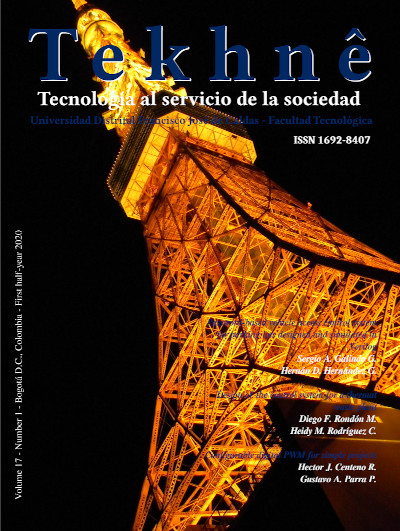Published:
2020-06-26Issue:
Vol. 17 No. 1 (2020): Tekhnê JournalSection:
ArticlesConfigurable digital PWM for simple projects
PWM digital configurable para simples proyectos
Keywords:
Digital circuit, hardware description, PWM, Verilog (en).Keywords:
Circuito digital, descripción por hardware, PWM, Verilog (es).Downloads
Abstract (en)
This paper presents the software implementation of an adjustable PWM (Pulse Width Modulator) prototype, developed in Verilog code, which functions as a training tool at the undergraduate level, or for the development of small projects. At the schematic level, the prototype presents the main module called PWM which integrates three modules (frequency, useful cycle, and display), as a complement to carry out results under the conditions specified in the functional profile. The base module integrates combinational and sequential circuits, i.e. counters, comparators, flip flops, function generators, etc. The final results obtained by simulation show the expected behavior in terms of frequency setting, duty cycle, and display.
Abstract (es)
Este artículo presenta la implementación, en cuanto a software, de un prototipo de PWM (Modulador por Ancho de Pulso) ajustable, desarrollado en código Verilog, que funcione como herramienta de formación en el ámbito de pregrado, o el desarrollo de pequeños proyectos. En cuanto a esquema, el prototipo presenta un módulo principal llamado PWM el cual integra tres módulos (frecuencia, ciclo útil y display), como complemento para llevar a cabo resultados bajo las condiciones especificadas en el perfil funcional. La base de los módulos integra circuitos combinacionales y secuenciales, es decir contadores, comparadores, Flip Flops, generadores de funciones, etc. Los resultados finales obtenidos por simulación muestran el comportamiento esperado en cuanto a ajuste de frecuencia, ciclo útil y visualización.
References
Cooper, M., & Stowe, R. (2018). Chemistry education research: From personal empiricism to evidence, theory, and informed practice. Chemical Reviews,
(12), 6053–6087. https://doi.org/10.1021/acs.chemrev.8b00020
Deepa, K., Kumar, P., Krishna, V., Rao, P., Mounika, A., & Medhini, D. (2017). A study of comparative analysis of different pwm techniques. 2017 International Conference On Smart Technologies For Smart Nation (SmartTechCon), 1144–1149.
Leon, J., Kouro, S., Franquelo, L., Rodriguez, J., & Wu, B. (2016). The essential role and the continuous evolution of modulation techniques for voltage-source inverters in the past, present, and future power electronics. IEEE Transactions on Industrial Electronics, 63(5), 2688–2701.
Martínez, F., & Gómez, D. (2007). Fuzzy logic controller for boost converter with active power factor correction. 7th International Conference on Power Electronics ICPE, 936–940.
Peddapelli, S. (2017). Pulse width modulation: Analysis and performance in multilevel inverters. De Gruyter Oldenbourg.
Posada Contreras, J. (2005). Modulación por ancho de pulso (pwm) y modulación vectorial (svm). una introducción a las técnicas de modulación. El Hombre y la Máquina. https://www.redalyc.org /articulo.oa
Zope, P., Bhangale, P., Sonare, P., & Suralkar, S. (2012). Design and implementation of carrier based sinusoidal pwm inverter. International Journal of Advanced Research in Electrical, Electronics and Instrumentation Engineering, 1(4), 230–236.
How to Cite
APA
ACM
ACS
ABNT
Chicago
Harvard
IEEE
MLA
Turabian
Vancouver
Download Citation
Visitas
Downloads
License
Copyright (c) 2020 Hector J. Centeno R., Gustavo A. Parra P.

This work is licensed under a Creative Commons Attribution-NonCommercial-NoDerivatives 4.0 International License.
Those authors who have published with this journal agree to the following terms:
- The authors retain their copyright and guarantee to the journal right of first publication of his work, which will be simultaneously subject to license recognition of Creative Commons that allows others to share the work as long as its author is indicated and its first publication in this journal.
- Authors may adopt other agreements nonexclusive distribution version of the work as long as indicated that the initial publication is in this journal.
- It allows and encourages authors disseminate their work via the Internet before and during the submission process, which can produce interesting exchanges and increase citations of the published work.


